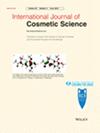Topical tretinoin is the mainstay of treatment for photoageing, despite the risk of skin irritation. Cosmetic combination anti-ageing formulations may offer similar efficacy to tretinoin, while improving on tolerability. We aim to demonstrate facial appearance benefits of a novel triple-active cosmetic formulation containing 4-hexylresorcinol, retinyl propionate, and niacinamide and to identify transcriptomic biomarkers underpinning these benefits.
A cosmetic prototype formulation containing 4-hexylresorcinol, retinyl propionate, and niacinamide was evaluated ex vivo and in a clinical study. For ex vivo experiments, the cosmetic formulation was applied for 3 days to healthy surgical discard skin from female donors aged 31–51 years, with tissues harvested for gene expression and histologic analyses. In the clinical study, females aged 47–66 years with moderate-to-severe overall visual photodamage on the face applied either topical 0.02% tretinoin or the cosmetic formulation to the face for 16 weeks and to forearms for 1 week, with forearm biopsies taken for gene expression analyses. Visual grading for facial photodamage and VISIA-CR images was taken throughout the clinical study. Safety was visually assessed during site visits, and adverse event monitoring was conducted throughout.
Gene expression analyses in both studies revealed modulation of pathways associated with skin rejuvenation, with several genes of interest identified due to being implicated in ageing and differentially expressed following the application of the cosmetic formulation. Reversal of a consensus skin ageing gene signature was observed with the cosmetic formulation and tretinoin in the ex vivo and clinical studies. Both the cosmetic formulation and tretinoin clinically improved the overall appearance of photoageing, crow's feet, lines, wrinkles, and pores. Adverse event reporting showed that the cosmetic formulation caused less skin irritation than tretinoin.
In a double-blind clinical study, the novel triple-active cosmetic combination formulation improved the visual appearance of photoageing similarly to prescription tretinoin. The cosmetic formulation and tretinoin reversed a consensus gene signature associated with ageing. Together with adverse event reporting, these results suggest that the cosmetic formulation may be a well-tolerated and efficacious alternative to tretinoin for improving the visual features of photoageing.



